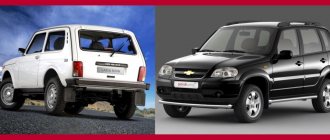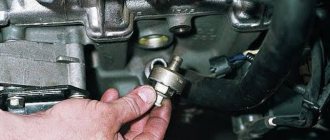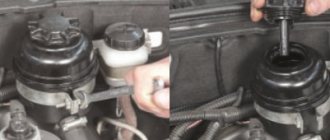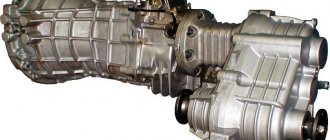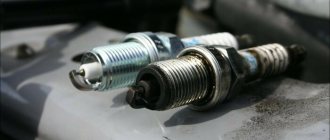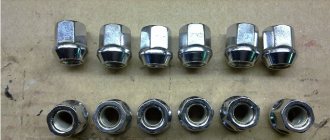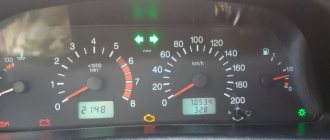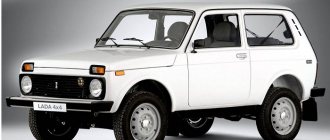Why measure tire pressure on Niva Chevrolet
Before you start measuring tire pressure, you need to decide on the units of pressure measurement. The most common are bar and atmosphere (atm.). Many people consider them identical, but this is not entirely true. If we take one normal atmosphere (760 mm Hg) as 1, then 1 bar will be 1.0133 atm. The difference of less than 2% is caused by the peculiarity of the mmHg conversion. Art. to Pascals in the SI system. All modern pressure gauges are marked in bars or atmospheres.
Timely monitoring of tire pressure affects:
- stability of straight motion;
- maximum braking distance of a car;
- stability and safety of control in extreme conditions;
- uniform tire tread wear;
- eliminates damage to tire sidewalls and cords;
- reduces fuel consumption at all speeds.
The pressure in Niva Chevrolet tires may be too low or too high . The behavior of the car on the road differs from this value as follows.
Important! The nominal level for wheels with landing radius R15, R16 is taken to be the factory setting of 1.9 bar.
Blood pressure is higher than normal . The car's ride becomes harsher, the contact patch with the road surface decreases, and directional stability deteriorates. The braking distance increases greatly, especially on wet or slippery surfaces. Characteristic bald spots appear on the tread in the middle of the wheel. An overinflated wheel is much easier to damage, and strong impacts are transmitted to the disc and suspension elements.
Underinflated wheels increase the effort on the steering wheel of the car and significantly increase gas mileage. The behavior of the SUV on hard surfaces becomes slack, the car yaws and floats on the road at high speed. The tread wears out from the edges of the tire, and the sidewall becomes cracked. Such a wheel cannot protect the disc from a strong impact when falling into a hole.
Advice. If the pressure on all wheels is not uniform, the car will pull towards the flat tire.
The causes of flat tires are universal for all brands of cars - punctures, damage to the beads, curvature of the wheel rim, air leakage through the valve, drying out and loss of tightness of tires due to age.
Frequency of measurements on Chevrolet Niva
In order not to endanger your life and the lives of others, you need to check the tire pressure before each trip, especially over long distances. The sequence of actions is as follows:
- We check the readings using a pressure gauge as indicated in the instructions for it. Tires should not be warm. The car must sit for three hours.
- We compare the readings with the data in the table of permissible tire pressure for the Niva 21214 car.
- After 30-40 minutes, we repeat the measurement, and if the readings become low, it means there is a puncture. Keeping the data at the same level indicates that you can leave.
Recommendation: After the end of the trip, another measurement is taken 2.5-3 hours later. This requirement is optional. However, when you drive the next day, you won't be surprised by a flat tire. All wheels are checked, including the spare.
Instruments and methods for measuring pressure
Chevy Niva tire pressure measurements are carried out with any mechanical or electronic pressure gauge:
- Mechanical dial pressure gauges are considered simple and unpretentious devices. The operating principle is based on a cylinder with a piston and a spring, and an arrow associated with it. Measuring range from 0.1 bar to 8 bar. The disadvantage of pointer instruments is the low measurement accuracy and dependence on the ambient temperature (underestimates readings in winter). Pros: reliable and cheap, do not require a power source.
- Electronic or digital pressure gauges . Modern high-precision instruments. Models from well-known manufacturers have minimal errors. Equally accurate in winter and summer. Cons: high price, less reliability.
Important! Measurements are made with a stationary vehicle and cold tires. After driving, you should let the car sit for 2-3 hours in summer or up to half an hour in winter. The correct order of measurements is indicated in the instructions for the pressure gauge.
The disk-tire system is not completely sealed, especially on off-road vehicles , which include the Chevrolet Niva. Air under pressure will always find a place to escape, so such pressure checks should become regular, and not 1-2 times a year when changing tires. The optimal mode is to check once every 2-3 weeks, before a long trip and after off-road trips.
Advice. Many drivers forget about the condition of the spare tire and only remember it when changing it. A deflated spare wheel will not help if a tire punctures, and you will only be able to drive a deflated wheel for a few kilometers, after which the tire will most likely have to be thrown away.
Instruments for checking the degree of pumping
For cars such as the Chevrolet Niva, maintaining this parameter is especially important. The center of gravity of this car is high, and the car cannot be called stable, especially during emergency maneuvers. It is impossible to measure the degree of air compression in a tire without special measuring instruments.
Pressure gauges are used for these purposes. They are divided into two categories that differ structurally:
- Mechanical pressure gauge. A device for measuring tire pressure, having a mechanical drive and a dial indicator. Has a significant degree of error, long service life, does not require a power source.
- Electronic pressure gauge. Electronic type device with a screen for displaying measurement data. It is powered by an internal power source; when used correctly, the error tends to zero.
Important: The error of devices of the first type is greater in winter than in summer due to temperature deformations of mechanical parts. In cold weather, it is recommended to use only to get to the garage or service station. The disadvantage of electronic pressure gauges is that the battery can run out at the most inopportune moment.
Off-road wheels on Chevy Niva
The difference between special off-road tires and all-season tires lies in a different power structure and standard size. Among the manufacturers of mud tires for Chevrolet Niva, BFGoodrich, Cordiant, Forvard, Federal Mogul and others have proven themselves well. They produce tires in sizes 215/65/R15, 215/75/R15, 225/65/R15, which fit on the Niva with minimal modifications to the standard wheel arches. Tread type M/T or A/T.
Off-road tires are distinguished by increased lugs and a reinforced tire sidewall . In addition, it is elastic and works well when deflated to a minimum. The working pressure of mud tires directly depends on the type of terrain being overcome. On rocky soils it is recommended to pump up to 2.3-2.5 atmospheres. This increases the ground clearance and traction properties of the tires. On muddy ground, sand or snow, the pressure is released to 0.8-1 bar. The tires roll well and allow you to overcome very difficult areas.
Relieving pressure correctly
In order for the readings to be accurate, you need to remove the pressure correctly. This should be done this way:
- tires must be unheated;
- for the last 3 hours before measurement, the car should be at rest or drive no more than 1.5 kilometers;
- Measurements must be taken on all four wheels and the spare wheel.
Only in this case can the readings from the pressure gauge be considered correct.
Table of values for the required tire pressure level for the Chevrolet Niva:
| Automobile model | Years of production | Tire size | Front tire pressure (atm./psi) | Rear tire pressure (atm./psi) |
| Chevrolet Niva | 2004—2014 | 205/75 R15 | 2,1/30 | 2,1/30 |
| Chevrolet Niva | 2004—2014 | 205/70 R15 | 2,1/30 | 2,1/30 |
| Chevrolet Niva | 2004—2014 | 215/65 R16 | 2,2/31 | 2,2/31 |
The pressure standards for Niva wheels 2121 or 21214 must be indicated on a special metal plate. As a rule, it is attached to the door on the driver's seat side. If for some reason there is none, you can look at the data online. But in this case, it is better to take into account the readings only approximately.
You should also pay attention to the fact that the amount of air in the rear tires should be about 0.3-0.5 bar more. This is due to the fact that the load on the rear axle of the wheel is always greater than on the front.
Niva Chevrolet and low pressure wheels
Low-pressure tires or arched tires are highly specialized tires that are designed primarily for constant use in severe off-road conditions, in swampy areas, and deep snow. They differ from ordinary off-road wheels in their width, light weight, and the normal pressure in such wheels is 0.5-0.7 bar.
It is impossible to install low-pressure tires on a standard Chevrolet Niva without modifying the car . You will need to lift the car and suspension, change the main pairs, strengthen the suspension elements, and install a pumping system. Such tuning turns the Niva into an excellent rogue on any terrain.
Disadvantages of low pressure tires in everyday use:
- short wheel life;
- reduction of maximum speed;
- deterioration in controllability;
- decreased reliability of the vehicle transmission;
- transfer of the car to the section of self-propelled vehicles;
- increased gasoline consumption.
What pressure should be set in tires
Setting normal tire pressure will reduce vehicle maintenance costs by reducing fuel consumption and tire wear. In addition, the driving safety and maneuverability of the vehicle depend on the tire pressure.
The tire pressure for cars with an R 15 rim should be 1.9 kg/cm², and for a R16 rim, slightly higher than 2.0 kg/cm². On Chevrolet Niva cars with 4x4 axles in off-road conditions, as well as in winter when driving on loose snow, you can reduce the pressure to 1.2-1.5 kg/cm². On a flat, high-speed highway, many increase tire pressure by 0.1-0.2 kg/², although this leads to stiffer car suspension and reduces ride comfort.
Using a vehicle with tire pressures other than normal can lead to the following consequences:
- Increased wear on the vehicle's suspension and chassis parts.
- Driving on a flat tire will increase gas mileage because the tire has more contact with the road surface and the engine needs to develop more power. Due to this, tire wear will increase.
- With high tire pressure, contact with the road decreases and driving becomes unsafe, especially in winter.
Consequences of incorrect tire pressure
Most car owners should remember the manufacturer's recommended tire pressure value for Chevrolet Niva - 1.9 bar . This is a normal value that should be used as a starting point when making adjustments up or down. Minor deviations will not lead to adverse consequences. There may be an increase in fuel consumption or slight discomfort in the car interior.
But deviations from the norm of 0.5 atmospheres or more already have a serious impact on safety and controllability and cause increased tire wear. To avoid this, it is recommended to always have a high-quality pressure gauge in your car and regularly measure the pressure in all wheels, including the spare tire.
Chevrolet Spark tire pressure indicators
Many people consider the Chevrolet Spark to be a toy car, but this is not at all true. It doesn’t have much power, but it can quickly dodge at a traffic light. The recommended tire size for it is from R13 to R15. In summer, you need to inflate all wheels to 2.2 Bar, and in winter to 2.1 Bar. If you do not adhere to such indicators, then if the car is under-inflated, it will be difficult to control, and it will skid when turning, especially in winter.
When the atmospheric indicators are different in all tires, then this is the worst thing that can happen to the wheels.
In such a situation, underinflated tires will literally drive sideways, and fuel consumption will increase significantly. When the number of atmospheres does not match the recommended standards, this can lead to:
- tread wear;
- premature tire wear;
- deterioration of controllability;
- failure of the car's chassis;
- excessive fuel consumption.
So it’s better to adhere to these standards than to spend money on new spare parts and tires.
It is necessary to check the pressure only when the tires are cold, otherwise the pressure gauge will show an incorrect result.
The machine must be at rest for at least three hours for the pressure readings to become clear. As the tire heats up, the volume of air inside it also increases, so for accurate readings you need to take measurements on cold tires.
